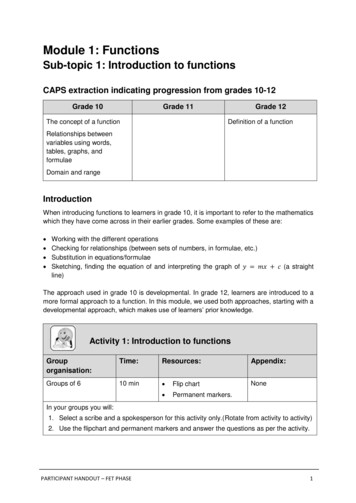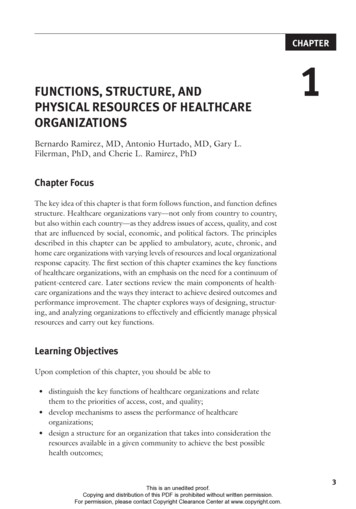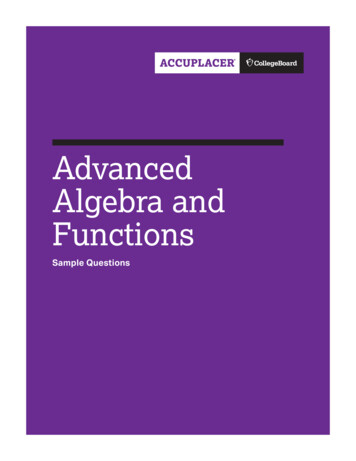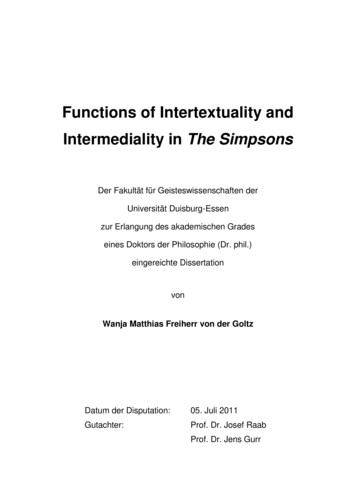
Transcription
Module 1: FunctionsSub-topic 1: Introduction to functionsCAPS extraction indicating progression from grades 10-12Grade 10Grade 11The concept of a functionGrade 12Definition of a functionRelationships betweenvariables using words,tables, graphs, andformulaeDomain and rangeIntroductionWhen introducing functions to learners in grade 10, it is important to refer to the mathematicswhich they have come across in their earlier grades. Some examples of these are: Working with the different operationsChecking for relationships (between sets of numbers, in formulae, etc.)Substitution in equations/formulaeSketching, finding the equation of and interpreting the graph ofline)(a straightThe approach used in grade 10 is developmental. In grade 12, learners are introduced to amore formal approach to a function. In this module, we used both approaches, starting with adevelopmental approach, which makes use of learners‟ prior knowledge.Activity 1: Introduction to :Groups of 610 min Flip chartNone Permanent markers.In your groups you will:1. Select a scribe and a spokesperson for this activity only.(Rotate from activity to activity)2. Use the flipchart and permanent markers and answer the questions as per the activity.PARTICIPANT HANDOUT – FET PHASE1
1. Complete the table below:x01234x21.11.21.31.41.5Write down some ordered pairs for the above table.Write down the equation represented by the information in the table.Draw the graph.Is there any restriction on the domain and range? Why?Write down the domain and range.2. The number of diagonals in a polygon is given by the following table:Number ofsides (x)345Number ofdiagonals(y)0252.12.22.32.42.567Complete the table.Draw the graph.Is there any restriction on the domain and range?Write down the domain and range.Determine the equation showing y in terms of x.Consolidation & TerminologyThe situations/relationships described in activity 1 represent functions. Use this informationto explain to your learners in very simple terms what a function is. Even though this ishandled in detail and formally assessed in grade 12, for grade 10 learners this isintuitive.NB: On page 131 of the Report on the 2013 National Senior Certificate (Diagnostic report), itwas noted that learners struggled to identify or define a function. They were not clear aboutterminology such as “one-to-many” and “many-to-many”.Definition:A function is a rule by means of which each element of a first set, called the domain, isassociated with only one element of a second set, called the range. Each element of therange is an image of corresponding elements of the range. Look at the following Venndiagrams.2PARTICIPANT HAND-OUT – FET PHASE
Not all elements of the domain and range are shown in the diagrams. We see that there is aone-to-one correspondence between the elements of the domain and elements of the range.If we represent number 1 from exercise 1 in a Venn diagram we get:We see that: Both 1 and -1 in the domain correspond to 1 in the range. Both 2 and -2 in the domain correspond to 4 in the range.This correspondence is many-to-one. When the correspondence is one-to-one or many-toone, we have functions; if the correspondence is one-to-many or many-to-many we do nothave functions.When determining whether a graph represents a function or not we make use of the“correspondence” reasons.However, we could also use a simple test called the “vertical line” test to determine whethera graph represents a function or not.PARTICIPANT HAND-OUT – FET PHASE3
If the vertical line cuts the graph at only one point, the graph represents a function; if it cutsat more than one point then the graph does not represent a function:Vertical lineThe vertical line cuts the graph at only one point so the graph will represent a function.Vertical lineThe vertical line cuts the graph at two points so the graph will not represent a function.(The circle and semi-circle is not prescribed in CAPS for this section. It is merely usedto show the vertical line test.)4PARTICIPANT HAND-OUT – FET PHASE
Worked Examples 1 & 2: Functional Notation (10 mins)The facilitator will now explain these suitable examples of functional notation.1. Remember to make notes as the facilitator is talking2. Ask as many questions as possible so as to clarify any misconceptions that may occur.1. Given that f ( x ) x 42Determine the following:1.1 f(1)1.2 f(-3)1.3 The value(s) of x if f ( x ) 0SolutionOnce again, for 1.1 and 1.2 it is simple substitution:1.1f (1) (1)2 4 1 4 31.2f ( 3) ( 3)2 4 9 4 51.3 For this question please note that f ( x ) 0 is not the same as f (0) .You may show learners this difference on a graph.f (x) 0 x2 4 0 ( x 2)( x 2) 0 x 2 or x 2We note that in this question we used factorisation to obtain the values of x.1. Given the following function:f (x) x2 9Determine:2.1 f (5)2.2 The value(s) of x if f ( x ) 2 .2.3 The domain of f.PARTICIPANT HAND-OUT – FET PHASE5
2.4 The range of f.Solution22.1 f (5) (5) 9 25 9 16 42.2f (x) 2 x2 9 2 x 2 9 4 (square both sides) x 2 13 x 132.3 The domain of f exists when x 9 0 (why? – this is a restriction)2x 2 9 0 (this is a simple quadratic inequality) ( x 3)( x 3) 0 x 3 or x 3NB: You may have to briefly revise how to solve quadratic inequalities.Thus, the domain is: {x: x -3, x R} {x: x 3, x R}2.4 Note thatindicates positive square root. Thus, our range can never be negative.Range {y: y 0, y R}Activity 2, 3 & 4: Functional Groups of 610 min Flip chartNone Permanent markers.In your groups you will:1. Select a scribe and a spokesperson for this activity only. (Rotate from activity to activity)2. Use the flipchart and permanent markers and answer the questions as per the activity.2. Use f ( x ) 2x 1 } and g(x) x 2 4 to determine:62.1f(-3)2.21 g(2) 32PARTICIPANT HAND-OUT – FET PHASE
x23. Use f ( x ) 2 x 1; g ( x ) and h( x ) 5 x to determine:x 33.1 h(-4) – f(-1)3.2 x if g(x) 03.3 the domain of g4. Use g ( x ) x 2to determine the domain of g.x 3Activity 5: Types of endix:Individual5 min NoneParticipants Handout1. Study the graphs that follow and state whether they represent functions or not. Giveyour reason/s in terms of correspondence.2.Write your answers in the space provided.(The circle and semi-circle is not prescribed in CAPS for this section. It is merely usedto show the vertical line test.)PARTICIPANT HAND-OUT – FET PHASE7
8PARTICIPANT HAND-OUT – FET PHASE
XEnrichmentGiven f ( x ) x2 2x 3We note that f represents a function because for each x-value (of the domain), there is onlyone y-value (of the range).To determine the correspondence, we try x -1 and x 1.f ( 1) f (1) ( 1)2 2x2 2 x 3 1 3(1)2 2x2 2 x 31 33233 42Thus, the correspondence is one-to-one.PARTICIPANT HAND-OUT – FET PHASE9
MisconceptionsTeachers should pay careful attention when working with functions which have restrictions asthese affect the domain and range of the said function. Learners tend to ignore restrictionson certain functions.Examples1. g ( x ) x 3 is a restricted function as x – 3 lies under the square root sox – 3 0, that is x 32. h( x ) 1is also a restricted function as x 2 cannot be 0 so x 2.x 23. The domain of f( x ) 2x 3 x 1 is not restricted but its range is restricted.2Please make learners aware of the following: The difference between g(0) and g(x) 0 The difference between g(2) and g(x) 2ConclusionWhen working with functions it is important to explain to learners how to get thecorrespondence. They should be able to look at any table, set of ordered pairs, equation orgraph and state what the correspondence is. Functions are a major portion of theMathematics paper 1 curriculum.NB: In each lesson please ensure that the lesson incorporates the following: Kinaesthetic learning – learners are given hands-on activities/exercises to work through. Auditory learning – using one‟s voice effectively without confusing learners. Visual learning – learners must be able to see. In the cases of graphs, there should besome colour and the various features shown.10PARTICIPANT HAND-OUT – FET PHASE
Sub-topic 2: Introduction to quadraticfunctions{( x; y ) : y a( x p)2 q}CAPS extraction indicating progression from grades 10-12Grade 10Point-by point plotting ofy x2Shape of functions, domain& range; axis of symmetry;turning points, intercepts onthe axesThe effect of a and q onfunctions defined byGrade 11Grade 12Revise the effect of theparameters a and q andinvestigate the effect of pand the function defined byy a( x p)2 qSketch graphs and find theequation of graphs andinterpret graphsy a.f ( x ) qwheref (x) x2Sketch graphs and find theequation of graphs andinterpret graphsIntroductionIt is important to note that the quadratic function is also known as the parabola.Study the picture below:This is an example of a parabola in real life. It is the St Louis Arch, which is located in thestate of Missouri in the United States of America.Accessed from: -tattoo/2/PARTICIPANT HAND-OUT – FET PHASE11
Another example of a parabola in real-life is to be found in car headlights.Accessed from http://www3.ul.ie/ rynnet/swconics/UP.htmThe general quadratic functionThe general formula for the quadratic function is: y a( x p) q , where a, p and q are all2real numbers. However a 0 . Why?We can simplify the quadratic function as follows:y a( x p )2 q a( x 2 2 px p 2 ) q ax 2 (2ap )x (ap2 q )) ax 2 bx c (where b 2ap and c ap 2 q )y ax 2 bx c is another way of writing the general formula of a quadratic function.Quadratic functions in the form y a( x p) q or y ax bx c represent the22parabola.Let b c 0 and let a 1Then we have a very simple parabola y x122PARTICIPANT HAND-OUT – FET PHASE
We can use simple substitution to obtain points on this function:x01-1-22-33y x20114499We can plot these points on the Cartesian plane:NB: The above sketch was drawn using GeoGebraFor the graph of y x the y values are negative.2x01-1-22-33y x 20-1-1-4-4-9-9PARTICIPANT HAND-OUT – FET PHASE13
Worked Examples 1-3: Simple sketches of quadraticFunctions(10 Mins)The facilitator will now take you through a number of sketches of quadratic functions.Example 11.1 Sketch the graphs of:y x2y 2x 2y 3x 21 2x21y x24y 1.2 What do you observe?SolutionWe can bring down the table and extend the number of rows:14x01-1-22-33y x20114499y 2x 2022881818y 3x 203312122727y 1 2x201212224,54,5y 1 2x401414112,252,25PARTICIPANT HAND-OUT – FET PHASE
1.1 Graphs:1.2 If a increases, the graph becomes narrower or stretches. As a decreases the graphbecomes wider or flatter.Example 22.1 Sketch the graphs of:y x2y 2 x 2y 3 x 21 2x21y x24y 2.2 What do you observe?PARTICIPANT HAND-OUT – FET PHASE15
Solution2.1 We can bring down the table and extend the number of rows:x01-1-22-33y x 20-1-1-4-4-9-9y 2x 20-2-2-8-8-18-18y 3 x 20-3-3-12-12-27-271y x220 12 12-2-2-4,5-4,51 2x40 14 14-1-1-2,25-2,25y 2.2 As a decreases the graph becomes narrower or stretches. As a increases the graphbecomes wider or flatter.Some properties of the function f {( x; y ) : y ax }2 16When a 0 , it has a minimum value. When a 0 , it has a maximum valueThe y-axis (x 0) is the axis of symmetryThe turning point is (0;0)Domain : 𝑅When a 0 , the range * : 0; 𝑅 When a 0 , the range : 0; 𝑅PARTICIPANT HAND-OUT – FET PHASE
Example 33.1 Sketch the graphs ofy x2y x2 4y x2 4Activity 1-3: Basic Pairs30 min NoneGraph Paper1. Read each question carefully.2. Discuss the question with your partner and proceed to answer the questions. You maydraw the graphs on the graph paper supplied and answer the questions alongside thegraphs.1. Given the function:f {( x; y ) : y 2x 2 }1.1 Sketch the graph of f.1.2 If f is moved 3 units downwards, to form the graph of g, determine the equationdefining graph g and its maximum value.1.3 Describe how the graph of y x2 may be transformed firstly to f and then to g.PARTICIPANT HAND-OUT – FET PHASE17
2. Sketch the graphs of g {( x; y ) : y 2x } and h {( x; y ) : y x 1} on the same2system of axes and determine the points of intersection.3. Given f {( x; y ) : y 2x 8}23.13.23.33.4Determine the y-intercept (that is, the value of f(0).Determine the x-intercepts.Does f have a maximum or minimum value? Explain your answer.Write down the coordinates of the turning point.3.5 Use the information in 3.1 to 3.4 to draw the graph of f {( x; y ) : y 2x 8}23.6 Join your y-intercept to your negative x-intercept. Call this line g. Determine theequation of g.EnrichmentParabolas and intersecting lines:The graph of y x 4 and y 22are drawn below:We note that there are 2 points of intersection.18PARTICIPANT HAND-OUT – FET PHASE
We can move y -2 down 2 units to get y -4.y 4 is a tangent to y x 2 4.If we move y -4 further down to say y -5 then we have:There are no points of intersection.PARTICIPANT HAND-OUT – FET PHASE19
Question:The graphs of y x 4 and y d are drawn. For what value(s) of d will there be:2(a) Two points of intersection? (two roots)(b) One point of intersection? (one root)(c) No points of intersection? (no roots)SolutionWe get the value(s) of d from the graphs(a) d 4(b) d 4(c) d 4This question can be phrased in another way. See below:Use your graph to determine the value(s) of d for which the roots of(a) Real and unequal (two points of intersection).(b) Real and equal (one point of intersection).(c) Non-real or imaginary (no points of intersection).x2 4 dMisconceptionsLearners must know the following: If the y-intercept of a graph is 6, then the coordinate of the point is (0;6). If the x-intercepts are -2 and 4, then the coordinates are (-2;0) and (4;0).ConclusionThe work done in this module only included examples of parabolas which had the y-axis asthe axis of symmetry. The graphs drawn were translated up and down the y-axis. Theseexamples provide more than suitable preparation for the ones that follow in the next module.20PARTICIPANT HAND-OUT – FET PHASE
Sub-topic 3: Sketching quadratic functionsIntroductionWe have seen from the previous module that the graph of {( x; y ) : y ax q } can be2stretched or flattened depending on the value of a. The value of q will dictate whether thegraph moves up or down the y-axis.For example the graph of g {( x; y ) : y 3 x 6} tells us that y x has been stretched22by a factor of 3 and moved 6 units down on the y-axis.We can see this in the graph below:A stretch by a factor of 3A move or translation of 6 unitsdownwardWe could also move y ax along the x-axis (left or right)2The graph of y a( x p)2PARTICIPANT HAND-OUT – FET PHASE21
Worked Examples 1-3: Simple sketches of quadraticFunctions(30 Mins)Pay careful attention as the facilitator discusses the various sketches of quadratic functions.Don’t forget to ask questions and make notes.Example 11.1 Sketch the following graphs on the same system of axes:y x2y ( x 2)2y ( x 3)21.2 What do you notice?Solution1.1 Graphs22PARTICIPANT HAND-OUT – FET PHASE
1.2 We also note that y ( x 3) is the graph of y x moved 2 units to the right (along22the x-axis). The turning point of y ( x 3) is (-3;0). We note that y ( x 2) is the2graph of y x22moved 3 units to the left (along the x-axis). The turning pint ofy ( x 2)2 is (2;0). Please make note of how the turning points change.Example 22.1 Sketch the following graphs on the same system of axes:y x2y x 2y 3( x 1)2y 2( x 2)22.2 What do you notice?Solution2.1 GraphsPARTICIPANT HAND-OUT – FET PHASE23
2.1 The graph of y x is a reflection of y x in the x-axis. The graph of y 3( x 1)222is a stretch of y x by a factor of 3, moved 1 unit to the right. The graph of2y 2( x 2)2 is a stretch of y x 2 by a factor of 3, moved 2 units to the left.Working with {( x; y ) : y a( x p) q }2Consider the example: f {( x; y ) : y 2( x 1) 8}2Without drawing the graph of f {( x; y ) : y 2( x 1) 8} we can make some2deductions about its properties:Firstly y 2( x 1) 8 is a move of y x 1 unit to the right, then a stretch by a factor22of 2, followed by a move of 8 units downward.The turning point of y 2( x 1) 8 is (1;-8). Do you know why this is the case?2Nowy 2( x 1)2 8 2( x 2 2 x 1) 8 2x 2 4 x 2 8 2x 2 4 x 6Thus, y 2x 4 x 8 is another way of writing y 2( x 1) 8 .22How do we transform y 2x 4 x 6 to y 2( x 1) 8 ?22We do it as follows:y 2x 2 4 x 6We can use the method of "completing the square"y 2( x 2 2 x ) 6(take coefficient of x2as common factor for first 2 terms)1 2( x 2 2 x 1 1) 6 (add and subtract coefficient of x within brackets) 2 2 2( x 1) 8 (first three terms form a perfect square; multiply 4th term by common factor and take outside)224PARTICIPANT HAND-OUT – FET PHASE
Example 33. Given the following:f {( x; y ) : y 2x 2 4x 6} {( x; y ) : y 2( x 1)2 8}3.13.23.33.43.5Determine the x and y-intercepts.Write down the coordinates of the turning point.Write down the equation of the axis of symmetry.Does the graph have a minimum or maximum value? Explain your answer.Draw the graph of f.Solution3.1 y intercept is f(0) -6x-intercepts:2x 2 4 x 6 0 x 2 2 x 3 0 (Divide by 2) ( x 1)( x 3) 0 x 1 or 33.2 Turning point (1;-8)3.3 x 13.4 The graph has a minimum value since a 2 (positive).3.5 GraphIn general, the following will apply:If f {( x; y ) : y ax bx c } then:2(1) Axis of symmetry:x b2a(2) Minimum or maximum value: y PARTICIPANT HAND-OUT – FET PHASE4ac b24a25
b 4ac b2 ; 4a 2a(3) Turning point (4) y- intercept occurs when x 0. Thus; y c (is the y-intercept).(5) x-intercepts occur when y 0, so ax bx c 0 . This is solved by factorisation orusing the formula.2NB: Gradients and average gradientsWe know learners should be familiar with straight line graphs from grade 9.The general form of a straight line function is ( x; y ) : ax by c If ax by c 0then by ax cac y x bbc a y mx k b m; b k where m is the gradient and k is the y intercept.Thus, in an equation such as y 2x 3 the gradient (m 2) is the same throughout.However, in a parabola, the gradient is changing all time. We can, however, find the averagegradient between two points on the parabola.Given: f ( x ) 2x 3 x 12XThe points A (-1;4) and B(0;-1) lie on the graph. The average gradient of the line joining A toB is calculated as follows:f ( x2 ) f ( x1 ) f (0) f ( 1) 1 4 5x2 x10 ( 1)126PARTICIPANT HAND-OUT – FET PHASE
Activity 1: Graphs and dix:Individual5 min NoneParticipant Handout1. Read each question carefully.2. Discuss the question with your partner and proceed to answer the questions in thespace provided below.The graphs of f ( x ) x 5x 6 and g( x ) x 6 are drawn below.2The intercepts with the axes (-6;0); (1;0); (0;6) and the turning point ( 2,5;12,25) areshown.Determine the following:The value(s) of x for which:(a) f ( x ) g ( x )(b) f ( x ).g( x ) 0PARTICIPANT HAND-OUT – FET PHASE27
Activities 2-4: dividual45 min Flipchart paperNone Whiteboard markersIn your groups you will:1. Select a scribe and a spokesperson for this activity only.(Rotate from activity toactivity).2. Use the flipchart and permanent markers and answer the questions as per the activity.2.Given: 𝑓*( ; ): 22 2.1 Sketch the graph of f.2.2 The graph of f is moved 3 units upward and 2 units to the right to form the graph g.Draw the graph of g on the same system of axes as f.2.3 Write down the defining equation of g.3. Sketch the graphs of f {( x; y ) : y 2x 4x } and g {( x; y ) : y 2x 2}same system of axes. The determine:2on the3.1 The value/s of x for which f ( x ) 03.2 The value/s of x for which g ( x ) f ( x )28PARTICIPANT HAND-OUT – FET PHASE
4. Given the graphs of f {( x; y ) : y 2x( x 4)} and g {( x; y ) : y 4x } drawn below:4.14.24.34.44.54.64.7Determine the value/s of x for which f(x) 0.Calculate P the turning point of f.Determine the average gradient of the curve of f between x -3 and 0.Hence, state what you can deduce about the function f between -3 and 0.Determine the value/s of x for which f(x) 0.Give the coordinates of the turning point of f(x 3)-1.For ℎ( ) 4 2 ( 4), determine the maximum value of h. For what value of xdoes this maximum occur?EnrichmentGiven f( x ) ax 2 bx c with a 0; b 0 and c 0.Draw a rough sketch of f(x)a 0The graph has a maximum value:a 0; b 0 bis positive (why)2a Thus the axis of symmetry is positivec 0The y-intercept is positive.So a rough sketch will look as follows:PARTICIPANT HAND-OUT – FET PHASE29
Given g( x ) ax 2 bx c with a 0; b 0 and c 0 and x-interceptsof different signs. Draw a sketch graph of gDraw a rough sketch of f(x)Possible graphIn module 2 we saw how quadratic functions and a straight line graph can be used todetermine roots of quadratic equations. Let us do another example:30PARTICIPANT HAND-OUT – FET PHASE
Suppose the following question was given:Use your graph(s) to find real value(s) of k for which x 5x 6 k has two negative,unequal roots.2We draw the graph of y x 5x 62XThe maximum value is found in two ways:We find the axis of symmetry and then substitute in the function to find the y value.x b( 5) 2,52a2( 1)y ( 2,5)2 5( 2,5) 6 12,25PARTICIPANT HAND-OUT – FET PHASE31
The maximum value is y 12,25.Another way of find the maximum value is:4ac b2 4( 1)(6) ( 5)2 49y 12,254a4( 1) 4We bring the graph down:XThe value of k must lie between the y- intercept (y 6) and the maximum value y 12,25for there to be two negative, unequal roots.Thus, 6 y 12,2532PARTICIPANT HAND-OUT – FET PHASE
MisconceptionsHighlight the following: The importance of correctly plotting points on the Cartesian Plane. Knowing the difference between the parabola and the cubic functionHow to work out:f (0) the y-intercept and its difference with f ( x ) 0 (calculation of the x-intercepts)ConclusionWhen working with your learners please point out the following: The need to practise working with graphs with both maximum and minimum values. Being able to interpret the different features of graphs. The intersection between a quadratic function (parabola) and a straight line and its linkto nature of roots. How to work out the product of functions and inequalities.PARTICIPANT HAND-OUT – FET PHASE33
Sub-topic 4: The hyperbolaGrade 10Point-by point plotting ofy 1xShape of functions, domain& range; axis of symmetry;turning points, intercepts onthe axesThe effect of a and q onfunctions defined byy a.f ( x ) qGrade 11Grade 12Revise the effect of theparameters a and q andinvestigate the effect of pand the function defined byy a qx pSketch graphs and find theequation of graphs andinterpret graphswheref (x) 1xSketch graphs and find theequation of graphs andinterpret graphsIntroductionAccessed from: per.htmlThe above diagram is Dulles Airport in the USA. It was designed by Eero Saarinen and is inthe shape of a hyperbolic paraboloid. The hyperbolic paraboloid is a three-dimensional curvethat is a hyperbola in one cross-section, and a parabola in another cross section.34PARTICIPANT HAND-OUT – FET PHASE
Now that we know what shape it is, let us find out more about the shape and properties ofthe hyperbola. We start with the general form of the hyperbola:The general form of the hyperbola is given by:ℎ{( ; ):} ℎ 𝑅 𝑅Let p 0 and q 0So we have: y If a 6 so y ax6 xy 6xWe can use a table to get both x and y values which satisfy this function:x1236-1-2-3-6y6321-6-3-2-1We now use point-by-point plotting to draw the graph of xy 6 or y 6. Please note thatxboth negative and positive values are used. We also join the points.PARTICIPANT HAND-OUT – FET PHASE35
Worked Examples 1- 4: Drawing a hyperbola(30 Mins)Pay careful attention as the facilitator discusses the sketches of the various hyperbolas.Don’t forget to ask questions and make notes.Example 1When p 0 in the function h we have:y a qx1.1 Sketch on the same system of axes, the graphs of:6x6y 2x6y 2xy 1.2 What do you observe?Solution1.1 We use Geogebra to sketch the graphs:66 2 is a translation of y two units upwards (along the y-axis).xx66We also note that y 2 is a translation of y two units downwards (along the yxx1.2 We note that y axis).36PARTICIPANT HAND-OUT – FET PHASE
Example 2Let q 0 in the function h. We have y ax p2.1 Sketch (on the same system of axes):y 6x6x 16y x 26y x 16y x 2y 2.2 What do you observe?Solution2.1 Once again we use Geogebra to draw these graphs2.2 We note the following:6does not cut the x-or y-axis.x The graph of y The others cut the y-axis but not the x-axis.The x-axis is a horizontal asymptote for all the graphs; the others have verticalasymptotes at different places (x -2; x -1; x 0; x 1; x 2). The graph of The graph of In general if y 6is the graph of𝑥:16is the graph of𝑥;26𝑥6𝑥shifted 1 unit to the left.shifted 2 units to the right.a, then the horizontal asymptote is the x-axis (y 0); while thex pvertical asymptote is when x pPARTICIPANT HAND-OUT – FET PHASE37
Example 33.Consider the most general form of the hyperbola: y Let y a qx p6 2x 1The vertical asymptote is calculated as follows:x 1 0 x 1The horizontal asymptote is the shift (the value of q). In this case it is y 2 .We can see this in the drawn graph of y We now see the graph of y 6 2 (below)x 16 2x 1The thick-broken lines show the asymptotes.Note: If a 0 then our curves are usually in the first and third quadrants.If a 0 then we work in the 2nd and 4th quadrants.38PARTICIPANT HAND-OUT – FET PHASE
Example 44.1 Sketch the graphs of: 4x 4y x 1 4y 1xy 4.2 Determine the asymptotes.Solution4.1 Graphs4.2 4 vertical asymptote is y -axis; horizontal asymptote is x -axisx 4y vertical asymptote is x 1; horizontal asymptote is x -axisx 1 4y 1 vertical asymptote is y -axis; horizontal asymptote is y 1xy Try to identify these asymptotes on the graph.PARTICIPANT HAND-OUT – FET PHASE39
Activities 1-4: The :Pairs(Not the same asbefore)60 min NoneGraph paper and A4SheetsTogether you will:1. Study the questions and answer them on the graph and A4 paper that is provided.Activity 11. Determine the asymptotes for each of the following functions:41.1 y x41.2 y x 241.3 y 2x41.4 y 2x 2Activity 22. Given f ( x; y ) : y 2.12.22.32.42.5 8 2 x 2 Determine the domain of f.Determine the coordinates of the x-and y-intercepts of f.Write down the equations of the asymptotes.Draw the graph of f.Now use your graph to determine the range of f.Activity 33. 10 The graph of g ( x; y ) : y is translated 3 units to the right and 4 unitsx upwards to form the graph of h. Determine the equation of hActivity 44.40Draw the graph of y x 2x 1PARTICIPANT HAND-OUT – FET PHASE
MisconceptionsLearners should be able to calculate the value of p and q from a drawn graph ofy a qx pLearners should know that another form of the hyperbola isx bx cx 25 x 35eg) y can be written as y 1x 3x 3x 3y ConclusionSummarise key points of this module:a q determines the location of the hyperbola.x p The value of a in y If a 0, it will be in the “first” and “third” quadrants; if a 0 it will be in the “second” and“fourth” quadrants.The vertical asymptote is calculated as x p 0 x p The horizontal asymptote is y qPARTICIPANT HAND-OUT – FET PHASE41
Sub-topic 5: The exponential functionCAPS extraction indicating progression from grades 10-12Grade 10Point-by point plotting ofy bxShape of functions, domain& range; axis of symmetry;turning points, intercepts onthe axesThe effect of a and q onfunctions defined byGrade 11Grade 12Revise the effect of theparameters a and q andinvestigate the effect of pand the function defined byy a.b x p q b 0; b 1Sketch graphs and find theequation of graphs andinterpret graphsy a.f ( x ) qwheref ( x ) bxSketch graphs and find theequation of graphs andinterpret graphsIntroductionExponential growth and decay is the rate of change in a graph, whether it is increasing ordecreasing.Real life examples of exponential growth are population, plants, animals and, ntial70.htmlThe graph below shows the compound growth on an investment of R5000,00 for n years at6% per annum, compounded annually.42PARTICIPANT HAND-OUT – FET PHASE
YXExamples of exponential decay are population (during genocide), the economy, the ozonelayer and the temperature of water.The graph below shows how a car worth R150,000 depreciates at 10% per annum accordingto the reducing balance method. This is an example of compound decay.yxThus, one can see why it is important to study the exponential function.PARTICIPANT HAND-OUT – FET PHASE43
x p q; b 0The exponential function ( x; y ) : y ab x p q; b 0The general form of the exponential function is given by: ( x; y ) : y abLet p 0; a 1; b 2; q 0 xSo we have: ( x; y ) : y 2
Sketch graphs and find the equation of graphs and interpret graphs Revise the effect of the parameters a and q and investigate the effect of p and the function defined by y a x p q ()2 Sketch graphs and find











